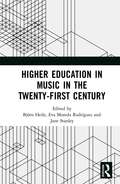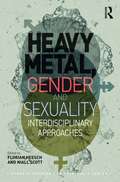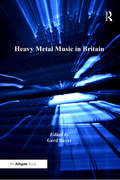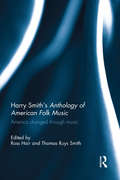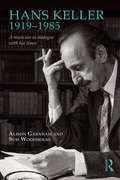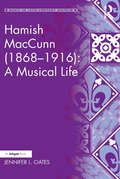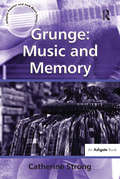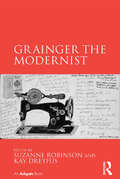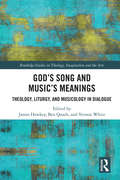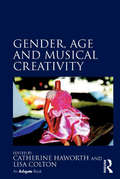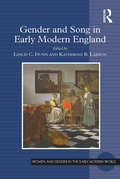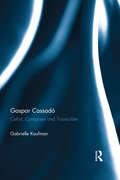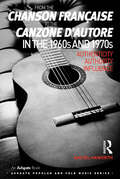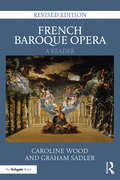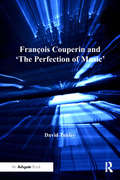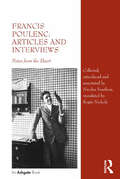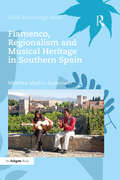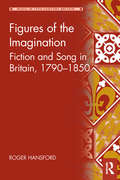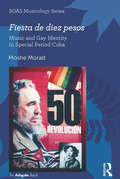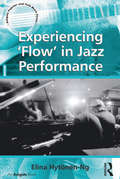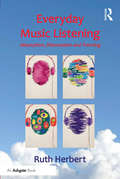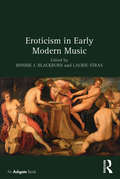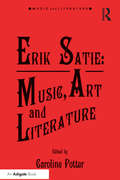- Table View
- List View
Higher Education in Music in the Twenty-First Century
by Björn Heile Eva Moreda Rodriguez Jane StanleyIn this book, the contributors reconsider the fundamentals of Music as a university discipline by engaging with the questions: What should university study of music consist of? Are there any aspects, repertoires, pieces, composers and musicians that we want all students to know about? Are there any skills that we expect them to be able to master? How can we guarantee the relevance, rigour and cohesiveness of our curriculum? What is specific to higher education in music and what does it mean now and for the future? The book addresses many of the challenges students and teachers face in current higher education; indeed, the majority of today’s music students undoubtedly encounter a greater diversity of musical traditions and critical approaches to their study as well as a wider set of skills than their forebears. Welcome as these developments may be, they pose some risks too: more material cannot be added to the curriculum without either sacrificing depth for breadth or making much of it optional. The former provides students with a superficial and deceptive familiarity with a wide range of subject matter, but without the analytical skills and intellectual discipline required to truly master any of it. The latter easily results in a fragmentation of knowledge and skills, without a realistic opportunity for students to draw meaningful connections and arrive at a synthesis. The authors, Music academics from the University of Glasgow, provide case studies from their own extensive experience, which are complemented by an Afterword from Nicholas Cook, 1684 Professor of Music at the University of Cambridge. Together, they examine what students can and should learn about and from music and what skills and knowledge music graduates could or should possess in order to operate successfully in professional and public life. Coupled with these considerations are reflections on music’s social function and universities’ role in public life, concluding with the conviction that a university education in music is more than a personal investment in one’s future; it contributes to the public good.
Heavy Metal, Gender and Sexuality: Interdisciplinary Approaches (Ashgate Popular and Folk Music Series)
by Florian Heesch Niall ScottHeavy Metal, Gender and Sexuality brings together a collection of original, interdisciplinary, critical essays exploring the negotiated place of gender and sexuality in heavy metal music and its culture. Scholars debate the current state of play concerning masculinities, femininities, queerness, identity aesthetics and monstrosities in an area of music that is sometimes mistakenly treated as exclusively sustaining a masculinist hegemony. The book combines a broad variety of perspectives on the main topic, regarding gender in connection to: the history of the genre; the range of metal subgenres; heavy metal's multidimensional scope (music, lyrics, performance, style, illustrations); men and women; sexualities and various local and global perspectives. Heavy Metal, Gender and Sexuality is a text that opens up the world of heavy metal to reveal that it is a very diverse and ground-breaking stage where gender play is at the centre of its theatricality and sustains its mass appeal.
Heavy Metal Music in Britain (Ashgate Popular and Folk Music Series)
by Gerd BayerHeavy metal has developed from a British fringe genre of rock music in the late 1960s to a global mass market consumer good in the early twenty-first century. Early proponents of the musical style, such as Black Sabbath, Deep Purple, Judas Priest, Saxon, Uriah Heep and Iron Maiden, were mostly seeking to reach a young male audience. Songs were often filled with violent, sexist and nationalistic themes but were also speaking to the growing sense of deterioration in social and professional life. At the same time, however, heavy metal was seriously indebted to the legacies of blues and classical music as well as to larger literary and cultural themes. The genre also produced mythological concept albums and rewritings of classical poems. In other words, heavy metal tried from the beginning to locate itself in a liminal space between pedestrian mass culture and a rather elitist adherence to complexity and musical craftsmanship, speaking from a subaltern position against the hegemonic discourse. This collection of essays provides a comprehensive and multi-disciplinary look at British heavy metal from its beginning through The New Wave of British Heavy Metal up to the increasing internationalization and widespread acceptance in the late 1980s. The individual chapter authors approach British heavy metal from a textual perspective, providing critical analyses of the politics and ideology behind the lyrics, images and performances. Rather than focus on individual bands or songs, the essays collected here argue with the larger system of heavy metal music in mind, providing comprehensive analyses that relate directly to the larger context of British life and culture. The wide range of approaches should provide readers from various disciplines with new and original ideas about the study of this phenomenon of popular culture.
Harry Smith's Anthology of American Folk Music: America changed through music
by Ross Hair Thomas Ruys SmithReleased in 1952, The Anthology of American Folk Music was the singular vision of the enigmatic artist, musicologist, and collector Harry Smith (1923–1991). A collection of eighty-four commercial recordings of American vernacular and folk music originally issued between 1927 and 1932, the Anthology featured an eclectic and idiosyncratic mixture of blues and hillbilly songs, ballads old and new, dance music, gospel, and numerous other performances less easy to classify. Where previous collections of folk music, both printed and recorded, had privileged field recordings and oral transmission, Smith purposefully shaped his collection from previously released commercial records, pointedly blurring established racial boundaries in his selection and organisation of performances. Indeed, more than just a ground-breaking collection of old recordings, the Anthology was itself a kind of performance on the part of its creator. Over the six decades of its existence, however, it has continued to exert considerable influence on generations of musicians, artists, and writers. It has been credited with inspiring the North American folk revival—"The Anthology was our bible", asserted Dave Van Ronk in 1991, "We all knew every word of every song on it"—and with profoundly influencing Bob Dylan. After its 1997 release on CD by Smithsonian Folkways, it came to be closely associated with the so-called Americana and Alt-Country movements of the late 1990s and early 2000s. Following its sixtieth birthday, and now available as a digital download and rereleased on vinyl, it is once again a prominent icon in numerous musical currents and popular culture more generally. This is the first book devoted to such a vital piece of the large and complex story of American music and its enduring value in American life. Reflecting the intrinsic interdisciplinarity of Smith’s original project, this collection contains a variety of new perspectives on all aspects of the Anthology.
Hans Keller 1919 - 1985: A musician in dialogue with his times
by Alison Garnham Susi WoodhouseHans Keller 1919–1985: A musician in dialogue with his times is the first full biography of Hans Keller and the first appearance in print of many of his letters. Eight substantial chapters, integrating original documents with their historical context, show the development of Keller’s ideas in response to the people and events that provoked them. A musician of penetrating insight, Keller was also an exceptional writer and broadcaster, whose remarkable mind dominated British musical life for forty years after the Second World War. It was a vital time for music in Britain, fuelled by unprecedented public investment in the arts and education and the rapid development of recording and broadcasting. Keller was at the centre of all that was happening and his far-sighted analysis of the period is deeply resonant today. Illustrated throughout by extracts from Keller’s writings, diaries and correspondence with musicians including Arnold Schoenberg, Benjamin Britten and Yehudi Menuhin, this book vividly conveys the depth of his thought and the excitement of the times. Published for the centenary of Keller’s birth, it is an illuminating celebration of his life and works for all those interested in the music and history of post-war Britain.
Hamish MacCunn: A Musical Life (Music in Nineteenth-Century Britain)
by Jennifer L. OatesHamish MacCunn’s career unfolded amidst the restructuring of British musical culture and the rewriting of the Western European political landscape. Having risen to fame in the late 1880s with a string of Scottish works, MacCunn further highlighted his Caledonian background by cultivating a Scottish artistic persona that defined him throughout his life. His attempts to broaden his appeal ultimately failed. This, along with his difficult personality and a series of poor professional choices, led to the slow demise of what began as a promising career. As the first comprehensive study of MacCunn’s life, the book illustrates how social and cultural situations as well as his personal relationships influenced his career. While his fierce loyalty to his friends endeared him to influential people who helped him throughout his career, his refusal of his Royal College of Music degree and his failure to complete early commissions assured him a difficult path. Drawing upon primary resources, Oates traces the development of MacCunn’s music chronologically, juxtaposing his Scottish and more cosmopolitan compositions within a discussion of his life and other professional activities. This picture of MacCunn and his music reveals on the one hand a talented composer who played a role in establishing national identity in British music and, on the other, a man who unwittingly sabotaged his own career.
Grunge: Music And Memory (Ashgate Popular and Folk Music Series)
by Catherine StrongGrunge has been perceived as the music that defined 'Generation X'. Twenty years after the height of the movement there is still considerable interest in its rise and fall, and its main figures such as Kurt Cobain and Courtney Love. As a form of 'retro' music it is even experiencing a resurgence, and Cobain remains an icon to many young music fans today. But what was grunge, and what has it become? This book explores how grunge has been remembered by the fans that grew up with it, and asks how memory is both formed by and forms popular culture. It looks at the relationship between media, memory and music fans and demonstrates how different groups can use and shape memory as part of an ongoing struggle for power in society. Grunge was the site of such a struggle, as popular music so often is, with the young people of the time asking questions about their place in the world and the way society is organized. This book examines what these questions were, and what has happened to them over time. It shows that although grunge challenged many social structures, the way it, and youth itself, are remembered often work to reinforce the status quo.
Grainger the Modernist
by Suzanne Robinson Kay DreyfusUnaccountably, Percy Grainger has remained on the margins of both American music history and twentieth-century modernism. This volume reveals the well-known composer of popular gems to be a self-described ’hyper-modernist’ who composed works of uncompromising dissonance, challenged the conventions of folk song collection and adaptation, re-visioned the modern orchestra, experimented with ’ego-less’ composition and designed electronic machines intended to supersede human application. Grainger was far from being a self-sufficient maverick working in isolation. Through contact with innovators such as Ferrucio Busoni, Léon Theremin and Henry Cowell; promotion of the music of modern French and Spanish schools; appreciation of vernacular, jazz and folk musics; as well as with the study and transcription of non-Western music; he contested received ideas and proposed many radical new approaches. By reappraising Grainger’s social and historical connectedness and exploring the variety of aspects of modernity seen in his activities in the British, American and Australian contexts, the authors create a profile of a composer, propagandist and visionary whose modernist aesthetic paralleled that of the most advanced composers of his day, and, in some cases, anticipated their practical experiments.
God’s Song and Music’s Meanings: Theology, Liturgy, and Musicology in Dialogue (Routledge Studies in Theology, Imagination and the Arts)
by Vernon White James Hawkey Ben QuashTaking seriously the practice and not just the theory of music, this ground-breaking collection of essays establishes a new standard for the interdisciplinary conversation between theology, musicology, and liturgical studies. The public making of music in our society happens more often in the context of chapels, churches, and cathedrals than anywhere else. The command to sing and make music to God makes music an essential part of the DNA of Christian worship. The book’s three main parts address questions about the history, the performative contexts, and the nature of music. Its opening four chapters traces how accounts of music and its relation to God, the cosmos, and the human person have changed dramatically through Western history, from the patristic period through medieval, Reformation and modern times. A second section examines the role of music in worship, and asks what—if anything—makes a piece of music suitable for religious use. The final part of the book shows how the serious discussion of music opens onto considerations of time, tradition, ontology, anthropology, providence, and the nature of God. A pioneering set of explorations by a distinguished group of international scholars, this book will be of interest to anyone interested in Christianity’s long relationship with music, including those working in the fields of theology, musicology, and liturgical studies.
Gender, Age and Musical Creativity
by Lisa Colton Catherine HaworthFrom the perennially young, precocious figure of 'little orphan Annie' to the physical and vocal ageing of the eighteenth-century castrato, interlinked cultural constructions of age and gender are central to the historical and contemporary depiction of creative activity and its audiences. Gender, Age and Musical Creativity takes an interdisciplinary approach to issues of identity and its representation, examining intersections of age and gender in relation to music and musicians across a wide range of periods, places, and genres, including female patronage in Renaissance Italy, the working-class brass band tradition of northern England, twentieth-century jazz and popular music cultures, and the contemporary 'New Music' scene. Drawing together the work of musicologists and practitioners, the collection offers new ways in which to conceptualise the complex links between age and gender in both individual and collective practice and their reception: essays explore juvenilia and 'late' style in composition and performance, the role of public and private institutions in fostering and sustaining creative activity throughout the course of musical careers, and the ways in which genres and scenes themselves age over time.
Gender and Song in Early Modern England (Women And Gender In The Early Modern World Ser.)
by Katherine R. Larson Leslie C. DunnSong offers a vital case study for examining the rich interplay of music, gender, and representation in the early modern period. This collection engages with the question of how gender informed song within particular textual, social, and spatial contexts in sixteenth- and seventeenth-century England. Bringing together ongoing work in musicology, literary studies, and film studies, it elaborates an interdisciplinary consideration of the embodied and gendered facets of song, and of song’s capacity to function as a powerful-and flexible-gendered signifier. The essays in this collection draw vivid attention to song as a situated textual and musical practice, and to the gendered processes and spaces of song's circulation and reception. In so doing, they interrogate the literary and cultural significance of song for early modern readers, performers, and audiences.
Gaspar Cassadó: Cellist, Composer and Transcriber
by Gabrielle KaufmanBarcelonian Gaspar Cassadó (1897-1966) was one of the greatest cello virtuosi of the twentieth century and a notable composer and arranger, leaving a vast and heterogeneous legacy. In this book, Gabrielle Kaufman provides the first full-length scholarly work dedicated to Cassadó, containing the results of seven years of research into his life and legacy, after following the cellist’s steps through Spain, France, Italy and Japan. The study presents in-depth descriptions of the three main parts of Cassadó’s creative output: composition, transcription and performance, especially focusing on Cassadó’s plural and multi-facetted creativity, which is examined from both cultural and historical perspectives. Cassadó’s role within the evolution of twentieth-century cello performance is thoroughly examined, including a discussion regarding the musical and technical aspects of performing Cassadó’s works, aimed directly at performers. The study presents the first attempt at a comprehensive catalogue of Cassadó’s works, both original and transcribed, as well as his recordings, using a number of new archival sources and testimonies. In addition, the composer’s significance within Spanish twentieth-century music is treated in detail through a number of case studies, sustained by examples from recovered score manuscripts. Illuminated by extraordinary source material Gaspar Cassadó: Cellist, Composer and Transcriber expands and deepens our knowledge of this complex figure, and will be of crucial importance to students and scholars in the fields of Performance Practice and Spanish Music, as well as to professional cellists and advanced cello students.
From the chanson française to the canzone d'autore in the 1960s and 1970s: Authenticity, Authority, Influence (Ashgate Popular and Folk Music Series)
by Rachel HaworthThe similarities between the chanson française and the canzone d'autore have been often noted but never fully explored. Both genres are national forms which involve the figure of the singer-songwriter, both experienced their golden age of production in the post-World War II period and both are enduringly popular, still accounting for a large proportion of record sales in their respective countries. Rachel Haworth looks beyond these superficial similarities, and investigates the nature of the relationship between the two genres. Taking a multidisciplinary approach, encompassing textual analysis of song lyrics, cultural history and popular music studies, Haworth considers the different ways in which French and Italian song is thought about, written about and constructed. Through an in-depth study of the discourse surrounding chanson and the canzone d'autore, the volume analyses the development of the genres' rules and rhetoric, identifying the key themes of Authority, Authenticity and Influence. The book finally considers the legacy of major artists, looking at modern perspectives on Georges Brassens, Jacques Brel, Léo Ferré, Fabrizio De André and Giorgio Gaber, ultimately affording a deeper understanding of the notions of quality and value in the context of chanson française and the canzone d'autore.
French Baroque Opera: Revised Edition
by Caroline Wood Graham SadlerFrom the outset, French opera generated an enormous diversity of literature, familiarity with which greatly enhances our understanding of this unique art form. Yet relatively little of that literature is available in English, despite an upsurge of interest in the Lully-Rameau period during the past two decades. This book presents a wide-ranging and informative picture of the organization and evolution of French Baroque opera, its aims and aspirations, its strengths and weaknesses. Drawing on official documents, theoretical writings, letters, diaries, dictionary entries, contemporary reviews and commentaries, it provides an often entertaining insight into Lully’s once-proud Royal Academy of Music and the colourful characters who surrounded it. The translated passages are set in context, and readers are directed to further scholarly and critical writings in English. Readers will find this new, updated edition easier to use with its revised and expanded translations, supplementary explanatory content and new illustrations.
Frank Zappa and the And (Ashgate Popular and Folk Music Series)
by Paul CarrThis collection of essays, documented by an international and interdisciplinary array of scholars, represents the first academically focused volume exploring the creative idiolect of Frank Zappa. Several of the authors are known for contributing significantly to areas such as popular music, cultural, and translation studies, with expertise and interests ranging from musicology to poetics. The publication presents the reader with an understanding of the ontological depth of Zappa's legacy by relating the artist and his texts to a range of cultural, social, technological and musicological factors, as encapsulated in the book's title - Frank Zappa and the And. Zappa's interface with religion, horror, death, movies, modernism, satire, freaks, technology, resistance, censorship and the avant-garde are brought together analytically for the first time, and approached non chronologically, something that strongly complies with the non linear perspective of time Zappa highlights in both his autobiography and recordings. The book employs a variety of analytical approaches, ranging from literary and performance theory, 'horrality' and musicology, to post modern and textually determined readings, and serves as a unique and invaluable guide to Zappa's legacy and creative force.
François Couperin and 'The Perfection of Music'
by David TunleyFrançois Couperin's contribution to the literature of baroque keyboard music has long been recognized. François Couperin and 'The Perfection of Music' updates and expands upon David Tunley's valuable 1982 BBC Music Guide to the composer, and examines the whole of Couperin’s output including the organ masses, motets and chamber music, in addition to the well-known works for harpsichord. Taking as its focal point Couperin's concept of the perfection of music through the union of the French and Italian styles, this book takes a more analytical approach to Couperin's work. Early chapters outline the main contrasting features of the two schools in the seventeenth- and early eighteenth-centuries, and it becomes clear that Couperin's expressive power owed much to his fusion of the polarities of the French classical tradition with that of the Italian baroque. The book features a number of appendices, including the prefaces to Couperin's work both in the original French and in English translation, and a glossary of dances of the French baroque.
Francis Poulenc: Notes from the Heart
by Roger Nichols Nicolas Southon’He plays the piano well,’ wrote the society hostess Mme de Saint-Marceaux in her diary on 18 March 1927. ’His compositions are not devoid of talent but he’s not a genius, and I’m afraid he thinks he is.’ Intelligent though the lady was, she got this one spectacularly wrong. Poulenc has in fact outpaced his colleagues in Les Six by many a mile, as singers and instrumentalists all over the world will attest, and while he would never have accepted the title of ’genius’, preferring ’artisan’, a genius is increasingly what he appears to have been. Part of the answer lay in always being his own man, and this independence of spirit shows through in his writings and interviews just as brightly as in his music, whether it’s boasting that he’d be happy never to hear The Mastersingers ever again, pointing out that what critics condemn as the ’formlessness’ of French music is one of its delights, voicing his outrage at attempts to ’finish’ the Unfinished Symphony, writing ’in praise of banality’ - or remembering the affair of Debussy’s hat. And in every case, his intelligence, humour and generosity of spirit help explain why he was so widely and deeply loved. This volume comprises selected articles from Francis Poulenc: J’écris ce qui me chante (Fayard, 2011) edited by Nicholas Southon. Many of these articles and interviews have not been available in English before and Roger Nichols's translation, capturing the very essence of Poulenc’s lively writing style, makes more widely accessible this significant contribution to Poulenc scholarship.
Flamenco, Regionalism and Musical Heritage in Southern Spain (SOAS Musicology Series)
by Matthew Machin-AutenriethFlamenco, Regionalism and Musical Heritage in Southern Spain explores the relationship between regional identity politics and flamenco in Andalusia, the southernmost autonomous community of Spain. In recent years, the Andalusian Government has embarked on an ambitious project aimed at developing flamenco as a symbol of regional identity. In 2010, flamenco was recognised as an Intangible Cultural Heritage of Humanity by UNESCO, a declaration that has reinvigorated institutional support for the tradition. The book draws upon ethnomusicology, political geography and heritage studies to analyse the regionalisation of flamenco within the frame of Spanish politics, while considering responses among Andalusians to these institutional measures. Drawing upon ethnographic research conducted online and in Andalusia, the book examines critically the institutional development of flamenco, challenging a fixed reading of the relationship between flamenco and regionalism. The book offers alternative readings of regionalism, exploring the ways in which competing localisms and disputed identities contribute to a fresh understanding of the flamenco tradition. Matthew Machin-Autenrieth makes a significant contribution to flamenco scholarship in particular and to the study of music, regionalism and heritage in general.
Figures of the Imagination: Fiction and Song in Britain, 1790–1850 (Music in Nineteenth-Century Britain)
by Roger HansfordThis new study of the intersection of romance novels with vocal music records a society on the cusp of modernisation, with a printing industry emerging to serve people’s growing appetites for entertainment amidst their changing views of religion and the occult. No mere diversion, fiction was integral to musical culture and together both art forms reveal key intellectual currents that circulated in the early nineteenth-century British home and were shared by many consumers. Roger Hansford explores relationships between music produced in the early 1800s for domestic consumption and the fictional genre of romance, offering a new view of romanticism in British print culture. He surveys romance novels by Ann Radcliffe, Matthew Lewis, Sir Walter Scott, James Hogg, Edward Bulwer and Charles Kingsley in the period 1790–1850, interrogating the ways that music served to create mood and atmosphere, enlivened social scenes and contributed to plot developments. He explores the connections between musical scenes in romance fiction and the domestic song literature, treating both types of source and their intersection as examples of material culture. Hansford’s intersectional reading revolves around a series of imaginative figures – including the minstrel, fairies, mermaids, ghosts, and witches, and Christians engaged both in virtue and vice – the identities of which remained consistent as influence passed between the art forms. While romance authors quoted song lyrics and included musical descriptions and characters, their novels recorded and modelled the performance of songs by the middle and upper classes, influencing the work of composers and the actions of performers who read romance fiction.
Fiesta de diez pesos: Music And Gay Identity In Special Period Cuba (SOAS Studies in Music Series)
by Moshe MoradThe ‘Special Period’ in Cuba was an extended era of economic depression starting in the early 1990s, characterized by the collapse of revolutionary values and social norms, and a way of life conducted by improvised solutions for survival, including hustling and sex-work. During this time there developed a thriving, though constantly harassed and destabilized, clandestine gay scene (known as the ‘ambiente’). In the course of eight visits between 1995 and 2007, the last dozen years of Fidel Castro’s reign, Moshe Morad became absorbed in Havana’s gay scene, where he created a wide social network, attended numerous secret gatherings-from clandestine parties to religious rituals-and observed patterns of behavior and communication. He discovered the role of music in this scene as a marker of identity, a source of queer codifications and identifications, a medium of interaction, an outlet for emotion and a way to escape from a reality of scarcity, oppression and despair. Morad identified and conducted his research in different types of ‘musical space,’ from illegal clandestine parties held in changing locations, to ballet halls, drag-show bars, private living-rooms and kitchens and santería religious ceremonies. In this important study, the first on the subject, he argues that music plays a central role in providing the physical, emotional, and conceptual spaces which constitute this scene and in the formation of a new hybrid ‘gay identity’ in Special-Period Cuba.
Experiencing 'Flow' in Jazz Performance (Ashgate Popular and Folk Music Series)
by Elina Hytonen-NgThe term 'flow' refers to experiences where the musician moves into a consciousness in which time seems to be suspended and perception of reality is blurred by unconscious forces. An essential part of the jazz tradition, which often serves as the foundation of the musician's identity, flow is recognised within the greater jazz community as a critical factor in accomplished musicianship. Flow as a concept is so deeply embedded in the scene that these experiences are not generally discussed. It contributes to the musicians' work motivation, providing a vital level of satisfaction and accomplishment. The power of the experience, consciously or unconsciously, has given rise to the creation of heroic images, in which jazz musicians are seen as being bold, yet vulnerable, strong and masculine, but still capable of expressing emotions. In this discourse, musicians are pictured as people constantly putting themselves on the line, exposing themselves and their hearts to one another as well as to the audience. Heroic profiles are richly constructed within the jazz scene, and their incorporation into narratives of flow suggests that such images are inseparable from jazz. It is thus unclear how far the musicians are simply reporting personal experience as opposed to unconsciously perpetuating a profoundly internalised mythology. Drawing on eighteen interviews conducted with professional jazz musicians from around the world, Elina Hytönen-Ng examines the fundamentals of the phenomenon of flow in jazz that has led to this genre's popularity. Furthermore, she draws on how flow experiences are viewed and constructed by jazz musicians, the meanings they attach to it, and the quality of music that it inspires.
Everyday Music Listening: Absorption, Dissociation and Trancing
by Ruth HerbertIn what ways does listening to music shape everyday perception? Is music particularly effective in promoting shifts in consciousness? Is there any difference perceptually between contemplating one's surroundings and experiencing a work of art? Everyday Music Listening is the first book to focus in depth on the detailed nature of music listening episodes as lived mental experiences. Ruth Herbert uses new empirical data to explore the psychological processes involved in everyday music listening scenarios, charting interactions between music, perceiver and environment in a diverse range of real-world contexts. Findings are integrated with insights from a broad range of literature, including consciousness studies and research into altered states of consciousness, as well as ideas from ethology and evolutionary psychology, suggesting that a psychobiological capacity for trancing is linked to the origins of making and receiving of art. The term 'trance' is not generally associated with music listening outside ethnomusicological studies of strong experiences, yet 'hypnotic-like' involvements in daily life have long been recognized by hypnotherapy researchers. The author argues that multiply distributed attention - prevalent in much contemporary listening- does not necessarily indicate superficial engagement. Music emerges as a particularly effective mediator of experience. Absorption and dissociation, as manifestations of trancing, are self-regulatory processes, often operating at the level of unconscious awareness, that support individuals' perceptions of psychological health. This fascinating study brings together research and theory from a wide range of fields to provide a new framework for understanding the phenomenology of music listening in a way that will appeal to both specialist academic audiences and a broad general readership.
Eroticism in Early Modern Music
by Laurie Stras Bonnie BlackburnEroticism in Early Modern Music contributes to a small but significant literature on music, sexuality, and sex in sixteenth- and seventeenth-century Europe. Its chapters have grown from a long dialogue between a group of scholars, who employ a variety of different approaches to the repertoire: musical and visual analysis; archival and cultural history; gender studies; philology; and performance. By confronting musical, literary, and visual sources with historically situated analyses, the book shows how erotic life and sensibilities were encoded in musical works. Eroticism in Early Modern Music will be of value to scholars and students of early modern European history and culture, and more widely to a readership interested in the history of eroticism and sexuality.
Erik Satie: Music Art And Literature (Music and Literature)
by Caroline PotterErik Satie (1866-1925) was a quirky, innovative and enigmatic composer whose impact has spread far beyond the musical world. As an artist active in several spheres - from cabaret to religion, from calligraphy to poetry and playwriting - and collaborator with some of the leading avant-garde figures of the day, including Cocteau, Picasso, Diaghilev and René Clair, he was one of few genuinely cross-disciplinary composers. His artistic activity, during a tumultuous time in the Parisian art world, situates him in an especially exciting period, and his friendships with Debussy, Stravinsky and others place him at the centre of French musical life. He was a unique figure whose art is immediately recognisable, whatever the medium he employed. Erik Satie: Music, Art and Literature explores many aspects of Satie's creativity to give a full picture of this most multifaceted of composers. The focus is on Satie's philosophy and psychology revealed through his music; Satie's interest in and participation in artistic media other than music, and Satie's collaborations with other artists. This book is therefore essential reading for anyone interested in the French musical and cultural scene of the late nineteenth and early twentieth century.
English Cathedral Music and Liturgy in the Twentieth Century
by Martin ThomasThis book examines the stylistic development of English cathedral music during a period of liturgical upheaval, looking at the attitudes of cathedral clergy, liturgists, composers, leading church music figures and organisations to music and liturgy. Arguments that were advanced for retaining an archaic style in cathedral music are considered, including the linking of musical style with liturgical language, the recommending of a subservient role for music in the liturgy, and the development of a language of fittingness to describe church music. The roles of the RSCM and other influential bodies are explored. Martin Thomas draws on many sources: the libraries and archives of English cathedrals; contemporary press coverage and the records of church music bodies; publishing practices; secondary literature; and the music itself. Concluding that an arresting of development in English cathedral music has prevented appropriate influences from secular music being felt, Thomas contrasts this with how cathedrals have often successfully and dynamically engaged with the world of the visual arts, particularly in painting and sculpture. Presenting implications for all denominations and for patronage of the arts by churches, and the place of musical aesthetics in the planning of liturgy, this book offers an important resource for music, theology, liturgy students and ministry teams worldwide.
